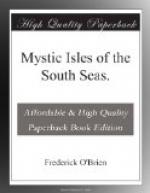He walked on before me to the fare, and, opening the door, bade me welcome. The house differed from the aboriginal in a wooden floor and three walls of wire screen above four feet of wainscot. The roof was lofty, of plaited pandanus-leaves, with large spaces under the eaves for the circulation of air; but the immediate suggestion was of an aviary, a cage thirty feet square. Attached to this room was a lean-to kitchen, and near by, hidden behind the cage, was another native house for sleeping. The aviary was the living- and dining-quarters, protected from all insect pests, and an arbor covered with vines led to the water.
Many canvases were about, on an easel an unfinished group of three Tahitian boys, and a case of books against the one solid wall.
Half a dozen Tahitian youths were lolling outside in the shade, and one, at the request of the host, led up the horse and the boy who guarded it. The child skirted the circumference of the monkey’s swing, and then, a few feet away, squatted to regard the animal with intense surprise and interest.
“Uritaata,” he said; “I never saw one before, but I have read in my school-book that they have those dogmen in French colonies.”
Uri means dog and taata man, and the compound name was that which sprang to the lips of the Tahitians on seeing a monkey, just as they called the horse puaa horo fenua, the pig that runs on the earth, and the goat, horo niho, the pig with horns. The pig and the dog were the only land mammals they knew before the white arrived. The race-track near Papeete was puaa horo fenua faa titi auraa. If a pig could talk, he would say that man was a wickeder and stronger pig. Jehovah has whiskers like a Rabbi. The Rabbis made him like themselves. Man has no other ideal.
The Tahitian youth addressed the Greek god as T’yonni, which was an effort to say John, and I adopted it instanter, as he did my own Maru. T’yonni said that Uritaata was the bane of his existence at Tautira. After building his fare he had been called to America, and had danced in Chinatown the night before his steamship departed for his return to Papeete. He remembered obscurely drinking grappo with a deep-sea sailor, and had awakened in his berth, the vessel already at sea, and Uritaata asleep at his feet. Many Tahitians, he said, had never seen such a fabulous brute, and T’yonni had stirred in them a mood of dissatisfaction by telling that their forefathers had descended from similar beings.
“How about Atamu and Eva?” they had asked the pastors.
Those conservatists had replied emphatically that Adam and Eve, the first man and woman, were created by God, which agreed thoroughly with the Tahitian legends, and after that T’yonni’s generosity was ranked higher than his knowledge. He laughed over the stories as we sat at breakfast with my coachman in the kitchen. T’yonni said that the deacon of the Protestant church expressed a belief that the Paumotuans or even the French might have followed the Darwinian course of descent, but that Tahitians could not swallow a doctrine that linked them in relationship with Uritaata. The Tongans, Polynesians like themselves, had a tradition that God made the Tongan first, then the pig, and lastly the white man.




